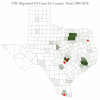Triangulating the New Frontier of Health Geo-Data: Assessing Tick-Borne Disease Risk as an Occupational Hazard among Vulnerable Populations
- PMID: 35954807
- PMCID: PMC9368420
- DOI: 10.3390/ijerph19159449
Triangulating the New Frontier of Health Geo-Data: Assessing Tick-Borne Disease Risk as an Occupational Hazard among Vulnerable Populations
Abstract
Determining interventions to combat disease often requires complex analyses of spatial-temporal data to improve health outcomes. For some vulnerable populations, obtaining sufficient data for related analyses is especially difficult, thus exacerbating related healthcare, research, and public health efforts. In the United States (U.S.), migrant and seasonal workers are especially affected in this regard, with data on health interventions and outcomes largely absent from official sources. In response, this study offers a multi-modal approach that involves triangulating geographically specified health data that incorporate reports on canine tick species, Lyme disease (LD) incidence, and patient symptom severity indicating potential subsequent disease burden. Spatial alignment of data at the U.S. county level was used to reveal and better understand tick-borne disease (TBD) incidence and risk among the identified populations. Survey data from migrant and seasonal workers in Texas were employed to determine TBD risk based on symptoms, occupations, and locations. Respondents who were found to have a higher likelihood of a TBD were also considerably more likely to report the most common symptoms of LD and other TBDs on the Horowitz Multiple Systemic Infectious Disease Syndrome Questionnaire. Those in the highly likely scoring group also reported more poor health and mental health days. Overall, a notable number of respondents (22%) were likely or highly likely to have a TBD, with particular relevance attributed to county of residence and living conditions. Also of note, almost a third of those reporting severe symptoms had received a previous Lyme disease diagnosis. These findings underscore the need for further surveillance among vulnerable populations at risk for TBDs.
Keywords: geo-data; migrant and seasonal workers; occupational hazards; tick-borne disease surveillance; triangulation; vulnerable populations.
Conflict of interest statement
The authors declare no conflict of interest.
Figures











Similar articles
-
Improving Surveillance of Human Tick-Borne Disease Risks: Spatial Analysis Using Multimodal Databases.JMIR Public Health Surveill. 2023 Aug 23;9:e43790. doi: 10.2196/43790. JMIR Public Health Surveill. 2023. PMID: 37610812 Free PMC article.
-
Assessing Tick-Borne Disease Risk and Surveillance: Toward a Multi-Modal Approach to Diagnostic Positioning and Prediction.Microorganisms. 2022 Apr 18;10(4):832. doi: 10.3390/microorganisms10040832. Microorganisms. 2022. PMID: 35456881 Free PMC article.
-
Tickborne disease awareness and protective practices among U.S. Forest Service employees from the upper Midwest, USA.BMC Public Health. 2020 Oct 20;20(1):1575. doi: 10.1186/s12889-020-09629-x. BMC Public Health. 2020. PMID: 33081728 Free PMC article.
-
Tick-Borne Diseases.Emerg Med Clin North Am. 2024 May;42(2):287-302. doi: 10.1016/j.emc.2024.01.004. Epub 2024 Feb 29. Emerg Med Clin North Am. 2024. PMID: 38641392 Review.
-
Detection, characterization, and prediction of tick-borne disease foci.Int J Med Microbiol. 2002 Jun;291 Suppl 33:11-20. doi: 10.1016/s1438-4221(02)80003-0. Int J Med Microbiol. 2002. PMID: 12141734 Review.
Cited by
-
Bird-tick and human-tick encounters in the Rio Grande Valley (Texas, USA): ecological associations and pathogen detections.Parasit Vectors. 2025 Mar 7;18(1):95. doi: 10.1186/s13071-025-06725-y. Parasit Vectors. 2025. PMID: 40055741 Free PMC article.
References
Publication types
MeSH terms
LinkOut - more resources
Full Text Sources
Medical
Research Materials

